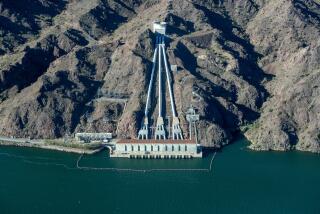Texas, New Mexico tangle over water
ALBUQUERQUE — The muddy Rio Grande isn’t much to look at as it meanders through southern New Mexico to the Texas border, but its waters are a high-stakes prize in a new legal row unfolding between the neighboring states.
This month, Texas asked the U.S. Supreme Court to hear its complaint that New Mexico has been diverting water it is obligated to send downstream under the 75-year-old Rio Grande Compact.
By allowing its residents to sink nearby wells and pump water from the river, “New Mexico has changed the conditions that existed in 1938 when the compact was executed,” the Texas complaint charges.
The dispute centers on the Rio Grande Project, a system of dams and canals that impounds water at the Elephant Butte and Caballo reservoirs in New Mexico and delivers it to farmers in southern New Mexico and West Texas. The compact among Colorado, New Mexico and Texas settled years of litigation by establishing a formula for allocating the river’s water to various users.
“All we’re trying to do is protect the project and its users,” says Pat Gordon, Texas’ representative on the Rio Grande Compact Commission. “There’s been a lot of tension for a lot of years. It seems that it’s gotten progressively worse.”
For one thing, he says, more than 2,500 wells have been drilled below Elephant Butte since the compact was signed. The wells cause water to flow from the river into the adjoining underground aquifer, he says, reducing the amount of water available for the irrigation network.
Meanwhile, Gordon says, New Mexico has “taken a very aggressive stance regarding what water would belong to the project” in a federal lawsuit it brought against the U.S. Bureau of Reclamation, which operates the project.
That stance has “greatly affected the state of Texas and had an impact on the action Texas had to take,” he says.
Sarah Bond, an assistant New Mexico attorney general, denied that her state had changed its interpretation of the accounting and delivery of water under the compact.
“We are in compact compliance,” Bond said in emailed comments. Referring to Texas’ request pending before the high court, she added, “We would not speculate on any ‘true motives’ for the Supreme Court action. It would appear they want more water delivered to them than their compact entitlement.”
Southern New Mexico farmers have long turned to pumping groundwater under drought conditions, as has the nearby city of El Paso and others in Texas, Bond said. Those drawing water from the river have been found to have water rights that predate the Rio Grande Project, she said.
“None of the actions of New Mexico farmers or river pumpers have been in violation of the compact,” she said.
Charles DuMars, a prominent water law specialist and former University of New Mexico law professor, says the dispute “has been brewing for a long time.” For years, New Mexico did not regulate groundwater pumping below Elephant Butte and only stopped issuing new well permits in 1980, he says.
Though the wells may be depleting the river’s flow, the compact only requires that New Mexico deliver a set amount of water into Elephant Butte Reservoir, DuMars says. As to what happens to the river between there and Texas, New Mexico’s water law probably applies, not the compact, he says.
But Carlos Rubinstein, a member of the Texas Commission on Environmental Quality, contends that the Supreme Court should handle the dispute because the compact “is an agreement between states and it was approved by Congress.”
Should the high court decide to step in, it would probably appoint a special master to take evidence, he says. Texas has prevailed in similar actions against New Mexico involving the Canadian and Pecos rivers, Rubinstein notes.
Water issues are taking on added urgency as hotter, drier conditions afflict Western states with their burgeoning urban populations. The Supreme Court agreed this month to hear another lawsuit from Texas over water — by a water district against Oklahoma. At issue is whether the Tarrant Regional Water District in northeastern Texas can use water supplies in Oklahoma.
In New Mexico, years of drought have left Elephant Butte water levels perilously low, and the mountains in northern New Mexico and southern Colorado are seeing lower-than-normal snowpack. Flow in the Rio Grande near Santa Fe this spring is projected to be just 47% of the 1981-2010 average.
DuMars predicts the case will drag on for years. Meanwhile, he says, “it’s really up to Mother Nature. If there is adequate snowpack for two or three years in a row and they can fill Elephant Butte, then it’s OK. But all the injunctions in the Supreme Court are not going to create snow.”
More to Read
Start your day right
Sign up for Essential California for news, features and recommendations from the L.A. Times and beyond in your inbox six days a week.
You may occasionally receive promotional content from the Los Angeles Times.






